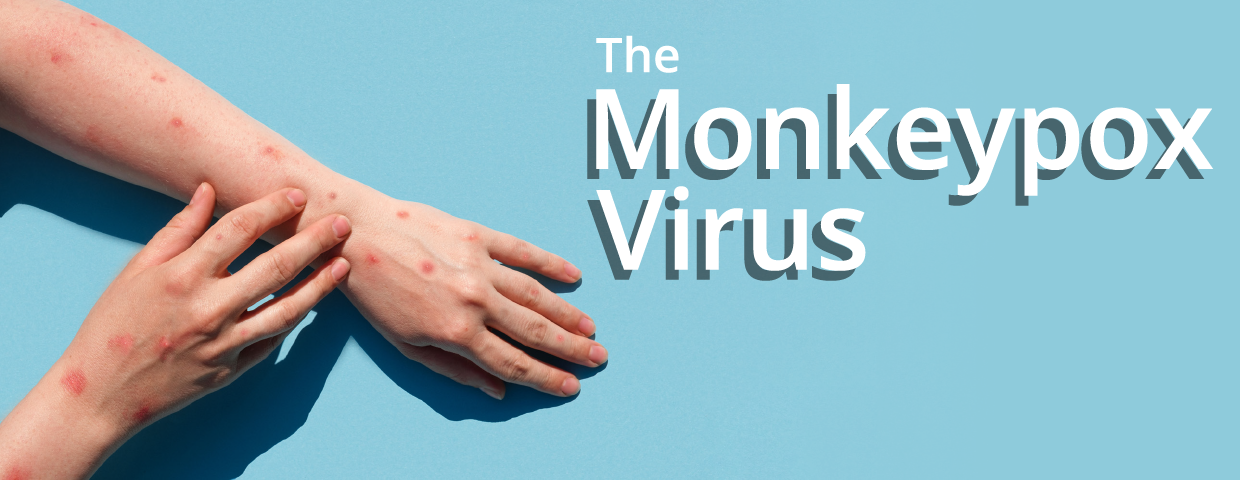The Monkeypox Virus
 THE ORIGINS OF MONKEYPOX
THE ORIGINS OF MONKEYPOX
The current Monkeypox infection outbreak is known to most people in the United States, due to the media coverage and cautions you see onscreen every day. Currently, the US has reported nearly 16,000 confirmed cases and more than 44,000 cases, globally. Fortunately, there are no reported deaths directly attributed to Monkeypox infection. (CDC)
Monkeypox is a rare infection caused by the Monkeypox Virus which is uncommon in the Western Hemisphere, and rarely fatal.
The first case of Monkeypox was reported in humans in 1970 in the Democratic Republic of Congo. Since then, there have been an increasing number of cases reported in Central and West Africa. There are two distinct genetic clades of the monkeypox virus: Central African (Congo Basin) clade and the West African clade. The Congo Basin clade has historically caused more severe diseases and was thought to be more transmissible. (World Health Organization)
While some may presume this is the first known outbreak of the Monkeypox virus within the United States, this is not the case. In 2003, the United States experienced an outbreak of the Monkeypox Virus with a total of 71 confirmed cases in the Midwest. This outbreak marked the first time Monkeypox infection appeared in the Western Hemisphere. There were no reported deaths and all reported cases involved direct contact with infected prairie dogs, not human-to-human transmission.
MONKEYPOX TRANSMISSION
The Monkeypox virus is generally expected to begin with animal-to-human transmission occurring when a human comes into direct contact with blood, bodily fluids, or lesions of infected animals. Some animals which are known to carry the virus may include: small vermin such as rats, squirrels, and different species of monkeys. Though the first infection has not been traced to any specific species, it is believed that rodents are most likely the original carriers.
According to the CDC, human-to-human transmission is spread through close, personal, often skin-to-skin contact, including:
- Direct contact with Monkeypox rash, scabs, or body fluids from a person with Monkeypox infection.
- Touching objects, fabrics (clothing, bedding, or towels), and surfaces that have been used by someone with Monkeypox infection.
- Contact with respiratory secretions.
- “Sexual contact” of any kind with a person with Monkeypox infection.
- Hugging, massage, and kissing.
- Prolonged face-to-face contact.
A person with Monkeypox can spread the virus to others from the time symptoms start until the rash has fully healed and a fresh layer of skin has formed. The illness typically lasts 2–4 weeks (CDC)
MONKEYPOX SIGNS AND SYMPTOMS
Monkeypox infection signs and symptoms can sometimes mimic sexually transmitted infections (STIs) and flu-like symptoms. If you contract Monkeypox, you may present signs and symptoms which may include:
- Rashes
- These may appear near the genitals and other areas such as the hands, feet, chest, face, and mouth.
- Fever
- Chills
- Swollen Lymph nodes
- Exhaustion
- Muscle aches and backaches
- Headache
- Stuffy/runny nose, cough, and sore throat
According to the CDC symptoms that are experienced may vary. You may experience all or only a few symptoms. Some infections present with only a rash, you may experience flu-like symptoms before the rash appears, or you may not experience symptoms until the rash has presented. If you experience any symptoms of Monkeypox, you should contact your primary care provider and refrain from intimacy with others until you have been cleared by a clinic.
TESTING FOR MONKEYPOX
If you are experiencing signs or symptoms of Monkeypox infection, and/or have been in contact with an infected person, contact your healthcare provider to determine if Monkeypox testing may be appropriate. A PCR test can help clinicians confirm potential infection.
Collection for the test can include a skin lesion swab. A healthcare provider will vigorously swab the surface of a suspected lesion to collect exudate which may contain the virus. This process may be uncomfortable but is necessary to obtain a proper specimen for testing.
A laboratory will test the collected specimen using molecular technology (e.g. PCR testing) and results are typically available within a few days. While awaiting results from suspected Monkeypox Virus infection testing, it is recommended to limit contact with others to prevent the virus from spreading.
TREATMENT FOR MONKEYPOX
There are no FDA-approved treatments for monkeypox. However, the CDC holds an expanded access Investigational New Drug (EA-IND) protocol, sometimes called “compassionate use,” that allows for use of an antiviral medication called TPOXX (tecovirimat) for the treatment of monkeypox. The safety and efficacy of TPOXX to treat monkeypox in humans have not been established. (FDA)
If you are experiencing any signs or symptoms of the Monkeypox viral infection or may have encountered someone who recently showed signs or symptoms of Monkeypox infection, you should contact your healthcare provider to determine if testing is appropriate.
HOW DTPM CAN HELP HEALTHCARE PROVIDERS REGARDING MONKEYPOX
DTPM now offers a *Monkeypox Virus (Orthopoxvirus) PCR test kit which detects Monkeypox Virus as well as differentiation between Western African and Congo Basin clades. For more information about testing and availability please contact a DTPM representative.
*For Research Use Only. Not for use In diagnostic procedures.
https://www.who.int/news-room/fact-sheets/detail/monkeypox
https://www.cdc.gov/poxvirus/monkeypox/transmission.html
https://www.cdc.gov/poxvirus/monkeypox/symptoms.html
https://www.accessdata.fda.gov/scripts/cder/daf/index.cfm
https://www.fda.gov/emergency-preparedness-and-response/mcm-issues/fda-monkeypox-response







